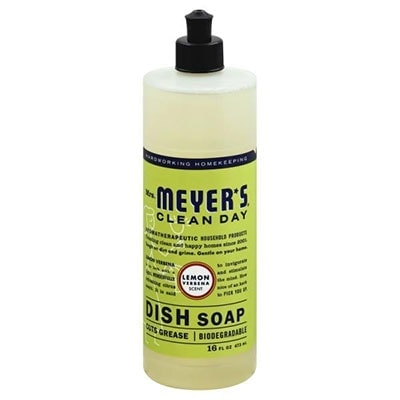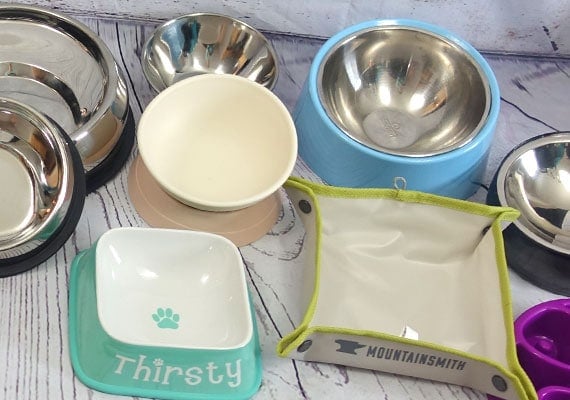To keep the lights on, we receive affiliate commissions via some of our links. Our review process.

How often do you wash your dog’s bowl?
Like most people, probably not enough.
Don’t feel guilty… It’s never too late to start!
Today, I’m going to teach you everything you need to know about cleaning your dog’s bowl!
Why do you need to clean your dog’s bowl?

Over the years, I have talked to many dog owners who didn’t clean their dog’s bowl. Ever.
Yes, you are reading that correctly…
It never actually occurred to these dog owners to wash their dog’s bowl.
No, these were not negligent pet owners. They were typical dog owners, like you or me, who simply didn’t know any better.
Is your dog bowl washing schedule similar? No need to feel guilty.
However, there is a very good reason why you should consider routinely washing your dog’s bowl…
The health of your precious pooch is at stake.
According to William Burkholder, DVM, from the Center for Veterinary Medicine at the Food and Drug Administration (FDA), the microbes from your dog’s saliva can be transferred to your dog’s bowl, creating an area where bacteria can flourish.[1]
“What kind of bacteria grow in the bowls depends on factors like the environment, exposure and oral hygiene of the animal, but possible examples include Staphylococcus aureus, Pasteurella multocida and different species of Corynebacterium, Streptococcus, Enterobacteria, Neisseria, Moraxella, Bacillus and, less frequently, Salmonella and Pseudomonas.”
In fact, a study done by NSF International found that pet food dishes are the 4th germiest product found in the average home.[2]
Now, your dog’s digestive system is well equipped to handle nasty bacteria like this…
And, it needs to be.
I mean, just this week, my dog has…
- Eaten my cat’s poop,
- Eaten another dog’s vomit, and
- Gnawed on a bone that he managed to hide in the garden weeks ago.
And, as I type this, he’s giving his butt a good lick.
Pretty gross, right? On its own, any one of those things would make you or me sick.
But for a dog, this is all normal. Which brings me to the argument I often see repeated…
My dog already eats gross things, and he’s fine. What’s a bit of crusty leftovers from dinner in his bowl?
It sounds logical, right? What’s yesterday’s uneaten meal compared to last month’s dog bone?
While it might sound like a good argument, the problem is these bacteria can all cause disease. This is a particular problem in young puppies, elderly dogs and dogs with weak immune systems.
I don’t have to tell you that cleaning your dog’s bowl is much cheaper than a trip to the vet.
But it’s not just your dog that these nasty germs can harm…
Young children can touch your dog’s bowl while playing on the floor, and then they may put their fingers in their mouths – this is why you should baby proof your dog bowl
On the other end of the age group, family members with weak immune systems are also at risk from the bacteria found in dirty dog bowls.
And, as if you needed another reason to wash your dog’s bowl…
Unclean bowls can stink. You might not notice it, but I bet your guests can. They are just being polite by not bringing it up.

Finally, if you feed your dog outside, any leftover food, no matter how small, is going to attract unwanted guests – ants!
These problems can be avoided with regular washing. So, why risk it?
How often should you wash your dog’s bowl?
Many vets agree that you should wash your dog’s bowl daily…
- Dog bowl with dry food – If you feed with kibble, your dog’s bowl should be washed daily, after the final meal of the day.
- Dog bowl with wet food – If you feed with canned food or raw meat, your dog’s bowl should be washed and sanitized after every meal.
- Dog bowl with water – Your dog’s water bowl should be washed once per day.
- Dog mat – If you use a mat to protect your floor or carpet from spills, then that too should be cleaned daily.
That’s some regular cleaning, right? If you have one of each, you’ll have to wash four different things each night.
I recommend buying a few different bowls so that you have a spare on hand while the others are in the wash. That way, your hungry dog won’t have to wait for you to clean his bowl before dinner is served.
How to clean your dog’s bowl
If you want to clean your dog’s bowl, you have two options:
1. Hand wash

Roll up your sleeves and get to work. While this might be the most labor-intensive method of washing your dog’s bowl, it’s also the fastest. If your dog bowl is not dishwasher-safe, then this is the only way to clean your dog bowl:

- Step one: Grab your dish soap
It all starts with a good dish soap. Because I want the best for my dog, I wash my dog’s bowl with the same natural dish soap I use on my own dishesIf you have never used this product, I recommend trying it. Affordable, free from nasty chemicals and, most importantly, cuts through grease and grime like it’s on a mission. And, it’s perfect for cleaning dog bowls.
- Step two: Grab a dedicated dog bowl sponge
While there is a lot I share with my dog, my kitchen sponge is where I draw the line. The kitchen sponge is already the germiest place in your house. And that’s without using your dish sponge on your dog’s bowl.[3]So, grab a second sponge or cloth that you only use on your dog’s bowl. Hint: Choose one in a different color from your usual sponge so that you can tell them apart. Also, if your dog’s bowl is plastic, make sure you choose a sponge made from a non-scratch material – any scuffs and scratches are breeding grounds for bacteria.
- Step three: Get washing!
Apply your dish soap to your sponge, and scrub your dog’s bowl under hot water, wiping away any grease or leftover dog food.Rinse with cool, clean water and dry.Yeah, that’s really all there is to it.
2. Dishwasher

If you are short on time, or just feeling lazy, then a trip through a dishwasher cycle is the easiest way to clean a dog bowl.
Just be mindful that not all dog bowls are dishwasher-safe. Make sure you check the washing instructions for your bowl.
- Plastic dog bowls – Generally top-rack dishwasher-safe
- Stainless steel dog bowls – Dishwasher-safe
- Ceramic dog bowls – Generally not dishwasher-safe
Note: If your dog’s stainless steel or plastic bowl has a non-skid rubber base, then it is not suitable for cleaning in the dishwasher.
How to remove dry, caked-on dog food

Maybe it’s been a while since you last washed your dog’s bowl. Or perhaps the hot sun caused uneaten food to harden like cement…
Whatever the reason, if you find yourself struggling to remove stubborn food from your dog’s bowl, then there is one thing you need to do:
Soak it!
Yep, a long soak in hot, soapy water is all it takes to soften and lift caked-on dog food.
Once done, hand wash your bowl, gently scrubbing to remove any remaining dog food that clings to the bowl.
How to sterilize your dog’s bowl

Just because your dog’s bowl looks clean doesn’t mean that it is germ-free.
A 2006 study showed that even after a rigorous hand wash with soap or a trip through the dishwasher, 67% or more bacteria (salmonella) remained.[4]
Dr. Jessica Vogelsang, renowned veterinarian and author, believes that in addition to daily cleaning, we should disinfect our dog’s bowl once a week.[5]
Fortunately, sanitizing your dog’s bowl is a quick and simple process…
After washing your dog’s bowl to remove any caked on food and other grime, follow these steps:
- Add ½ cup regular bleach to a gallon of water.
- Let the dog bowl sit for 10 minutes.
- Remove and rinse thoroughly with fresh water.
- Leave it to air dry.
This simple treatment will kill parvo, a leading killer of puppies under six months old (older dogs are not immune either).
Note: chlorine based disinfectants are unsuitable for stainless steel dog bowls and may cause them to rust.
How to skip cleaning your dog’s bowl when on vacation
As you see, keeping your dog’s bowl clean and sterilized is a fairly simple task.
But if you take your dog on vacation, it’s an extra chore that you probably don’t want.
That’s where a disposable dog bowl comes in…

Simply pour your dog’s meal inside and once he is finished, toss the bowl. No more cleaning dog bowls while on vacation!
Best of all, these bowls are compostable, meaning that unlike plastic bowls, they will break down when thrown away.
Conclusion
I know cleaning is a pain, but doing your doggy dishes is an essential part of keeping your dog and family healthy!
How often do you clean your dog’s bowl? Let me know in the comments below!
Tagged With:

